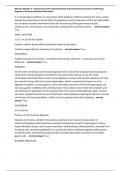NSG 521 Module 9 : Assessment of the Gastrointestinal and Genitourinary Systems and Nursing
Support of Urinary and Bowel Elimination
It is not possible to perform an assessment of the abdomen without realizing that every system
(except the respiratory) is found within the abdominal cavity. Awareness of this fact will enable
you to obtain valuable information about the functioning of the gastrointestinal (GI),
cardiovascular, reproductive, neuromuscular, and genitourinary (GU) systems. - correct answer
True
SMALL INTESTINE
5.5-6.1 m (18-20 ft) in adults
Propels contents by wormlike movements known as peristalsis
Primarily responsible for absorption of nutrients - correct answer True
ESOPHAGUS
Propels food into the stomach, controlled by the cardiac sphincter—a one-way valve at the
distal end - correct answer True
STOMACH
Site for both mechanical and chemical digestion:Churns food into small particles that become
liquid when mixed with gastric juicesStores food and slowly releases it into the small
intestineSecretes hydrochloric acid to aid in digestion; mucous cells secrete substances to coat
the stomach lining; chief cells secrete pepsinogen, which is converted to pepsin to aid in
digestion of protein; secretes gastrin, which stimulates secretion of acid and pepsinogen and
increases gastric motilitySecretes intrinsic factor that protects vitamin B12 from stomach acid
and facilitates its absorption by the parietal cells in the small intestineAbsorbs water, alcohol,
and some medicationsDestroys some food-borne bacteriaAllows emptying of stomach contents
on the basis of pressure gradient, a little at a time; gravity assists with emptying - correct
answer True
DUODENUM
25 cm (10 in.)
Primary site for chemical digestion
Enzymes, hormones, and bile from pancreas and liver enter and aid in absorption of
nutrients:Peptidases help break down proteins.Enterokinase converts trypsinogen to active
trypsin.Maltase, lactase, and sucrase break down carbohydrates.Cholecystokinin, secreted from
duodenal wall, stimulates gallbladder to secrete bile.Gastric inhibitory peptide inhibits gastric
motility.Secretin, secreted by duodenal wall, stimulates pancreatic secretions to neutralize
gastric acid. - correct answer True
JEJUNUM AND ILEUM
,NSG 521 Module 9 : Assessment of the Gastrointestinal and Genitourinary Systems and Nursing
Support of Urinary and Bowel Elimination
Jejunum: 2.4 m (8 ft)
Ileum: 3.7 m (12 ft)
Absorb water, nutrients, and electrolytes for use in body - correct answer True
LARGE INTESTINE
Ascending, transverse and descending colon
1.5-1.8 m (5-6 ft)
Absorbs salt and water and excretes waste products of digestive process from the rectum
(defecation)
Aids in synthesis of vitamin B12 and potassium - correct answer True
KIDNEYS
Control blood pressure through the production of renin
Stimulate red blood cell production by secreting erythropoietin
Remove waste products filtered by the kidneys from the body - correct answer True
BLADDER
Aids in the removal of waste products from the body in the form of urine - correct answer True
AORTA
Supplies oxygenated blood to the cells and organs of the lower half of the body - correct
answer True
LIVER (LOCATED IN RUQ)
Produces and secretes bile to emulsify fat
Metabolizes protein, carbohydrates, and fats
Converts glucose to glycogen and stores it
Produces clotting factors, fibrinogen, and plasma proteins such as albumin
Detoxifies drugs and alcohol
Stores fat-soluble vitamins A, D, E, and K; vitamin B12; and copper and iron
Converts conjugated bilirubin from blood to unconjugated bilirubin - correct answer True
GALLBLADDER
Located on back side of liver in RUQ
, NSG 521 Module 9 : Assessment of the Gastrointestinal and Genitourinary Systems and Nursing
Support of Urinary and Bowel Elimination
Stores and concentrates bile - correct answer True
PANCREAS
Located in LUQ
Endocrine functions:Secretes insulin and regulates blood glucose levelsSecretes glucagons that
store carbohydratesInhibits insulin and glucagon secretionSecretes pancreatic polypeptide that
regulates release of pancreatic enzymes
Exocrine functions:Secretes digestive enzymes. Amylase digests starches into maltose. Lipase
breaks down lipids into fatty acids and glycerol.Trypsinogen, chymotrypsinogen, and
procarboxypeptidase are activated in the small intestine to break down proteins into amino
acids. - correct answer True
Gastrointestinal Organs
The major GI organs found within the abdominal cavity include the stomach, small intestines,
and colon. Accessory organs of the GI system within the abdomen include the liver, pancreas,
and gallbladder. These organs are for ingestion, absorption, digestion, and elimination of food,
water, and body waste. - correct answer True
The spermatic cord protects the vas deferens, blood vessels, lymphatics, and nerves that run
from scrotum to penis. The ovaries produce ova and secrete estrogen and progesterone. The
uterus allows fertilization of the oocyte with sperm and, if conception occurs, provides an
environment for fetal development. Menstrual cycling, ovarian dysfunction, and uterine
growths are common sources of abdominal pain in women. - correct answer True
The hypothalamus is responsible for the release of FSH and LH by way of the gonadotropin-
releasing hormones (GnRH) and luteinizing-releasing hormones (LnRH). The hypothalamus acts
as an inhibitor of prolactin release via the secretion of prolactin inhibiting factors. These cyclic
hormones drive the function of menstruation, reproduction, sexuality, and physical as well as
emotional health (Fritz & Speroff, 2011). The pelvic organs are the recipients of the hormones -
correct answer
The ovaries, as already noted, produce estrogen and progesterone. Estrogen regulates the
development of secondary sex characteristics; contributes to the growth of the vagina, fallopian
tubes, and uterus; contributes to the proliferation of the endometrial lining and plays a role in
maturation of ovarian follicles. Progesterone is produced by the corpus luteum and is necessary
for maturation of the endometrial lining, the successful implantation of the embryo, and
maintenance of the uterine lining if implantation occurs. If no implantation happens,
progesterone levels drop and a menstrual cycle occurs. - correct answer
Liver - correct answer Stores fat-soluble vitamins A, D, E, and K; vitamin B12; and copper and
iron




